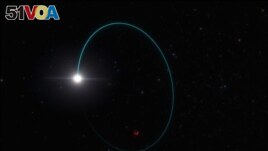20 April 2024
Astronomers have discovered a black hole with a mass about 33 times greater than that of our sun. It is the second biggest black hole known in the Milky Way. Only the supermassive black hole at the center of the galaxy is bigger.
The newly identified black hole is about 2,000 light-years from Earth says a new study in the publication Astronomy & Astrophysics. A light year is about 9.5 trillion kilometers.
The black hole is in the constellation Aquila, and has a companion star orbiting it, researchers said on Tuesday.

An artist's impression shows the orbits of the most massive stellar black hole in our galaxy, dubbed Gaia BH3and a companion star, in this handout image obtained by Reuters on April 16, 2024.
Black holes are extremely dense objects. They have gravity so strong not even light can escape, making it difficult to find them. The European Space Agency's Gaia mission found the black hole. Gaia is carrying out a huge stellar count.
The scientists saw that the black hole caused its companion star to wobble. Data from the European Southern Observatory's Chile-based Very Large Telescope and other ground-based observatories confirmed the black hole's mass.
"This black hole is not only very massive, it is also very peculiar," said Pasquale Panuzzo. He is a research engineer at the French research agency CNRS and lead writer of the study.
For instance, the black hole, called Gaia BH3, and its companion are traveling within the galaxy in the opposite direction of how stars usually orbit in the Milky Way.
Gaia BH3 probably formed after the supernova, or explosive death, of a star that was more than 40 times as large as the sun, the researchers said.
Black holes that result from the collapse of a single star are called stellar black holes. Gaia BH3 is the largest-known stellar black hole, said astronomer and study co-author Tsevi Mazeh of the Tel Aviv University in Israel.
Stellar black holes are small compared to supermassive black holes at the center of most galaxies. Sagittarius A* is the supermassive black hole at the heart of the Milky Way. It is 4 million times the mass of the sun and is located about 26,000 light-years from Earth.
Gaia BH3's progenitor star was made almost entirely of hydrogen and helium. Stars in the early universe were of similar chemical formation, known as low metallicity. The progenitor star had formed early in the universe's history, perhaps two billion years after the Big Bang. When it exploded at the end of its lifespan it released material into space. The remains violently collapsed to form a black hole.
The discovery of Gaia BH3 supports stellar evolution models showing that massive stellar black holes can be produced only by a low metallicity star like this one's progenitor star, Panuzzo said.
Gaia BH3's companion star is about 76 percent of the mass of the sun. It is a bit colder, but around 10 times brighter.
A measure called an astronomical unit (AU) is the distance between the earth and the sun. Gaia BH3's companion star orbits the black hole at a changing distance between 4.5 AU and 29 AU. By comparison, Jupiter orbits around 5 AU from the sun and Neptune around 30 AU.
Elisabetta Caffau is an Observatoire de Paris astronomer and a co-writer of the study. She said she was surprised that "the chemical composition of this companion star does not show anything special, so it was not affected by the supernova explosion of the black hole."
Scientists are not sure just how big stellar black holes can be.
"The maximum mass for a stellar black hole is a matter of active scientific debate," Panuzzo said.
I'm Dan Novak.
Dan Novak adapted this story for VOA Learning English based on reporting by Reuters.
_____________________________________________
Words in This Story
companion — n. a person or animal you spend time with or enjoy being with
mission — n. a task or job that someone is given to do
wobble — v. to move with an unsteady side-to-side motion
peculiar — adj. not usual or normal
progenitor — n. something that begins the development of something else
maximum — n. the highest number or amount that is possible or allowed